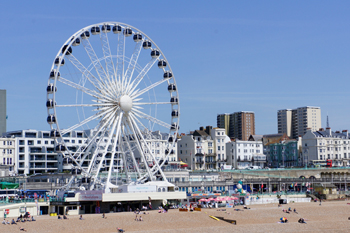
by Paris Franz
My trip to Brighton was both a response to the end of an excruciatingly long winter and an exercise in nostalgia. Brighton had been the destination of choice for many a day at the seaside during my childhood, and would be forever associated in my mind with windswept, pebbled beaches and ideas of escape. It’s been said you should never go back to places where you were happy, lest the reality not measure up to the memory, but how could I not? It’s less than an hour from London by train, and the sun was shining.
I set out from London Bridge Station and the chaos of its extensive refurbishment, prompted by the arrival of the gleaming and unlikely Shard next door, the tallest building in the European Union at 1,016 feet. It was, briefly, the tallest building in the whole of Europe, until the Mercury City Tower in Moscow overtook it.
My train left from platform five, departing smoothly with cool and quiet glory, so different from the noisy and stuffy trains of yore. The landscape was one of increasing greenery, complete with allotments and ponds, sheep and cows and horses. It struck me again, as it does every time I travel across England when the sun is shining, just how many shades of green there are, and how pretty the country is.
Taking the waters in Brighton
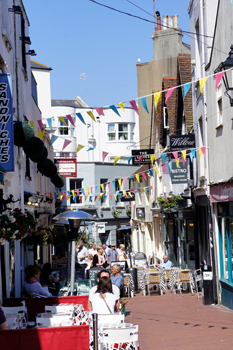 Brighton’s train station is still magnificently Victorian, with its soaring iron roof. The formerly sleepy fishing village of Brighthelmstone began to be transformed towards the end of the eighteenth century when the aristocracy arrived ‘to take the waters’, but it wasn’t until the arrival of the railway in the 1840s, that Brighton really put itself on the map and became the destination of choice for toffs and day-trippers alike.
Brighton’s train station is still magnificently Victorian, with its soaring iron roof. The formerly sleepy fishing village of Brighthelmstone began to be transformed towards the end of the eighteenth century when the aristocracy arrived ‘to take the waters’, but it wasn’t until the arrival of the railway in the 1840s, that Brighton really put itself on the map and became the destination of choice for toffs and day-trippers alike.
I can’t remember my first visit to Brighton. It’s all a jumble of memories – sunshine, wind, ice-cream on the pier, an unsuccessful experiment with candy-floss (I was a fastidious child). I remember stumbling across the pebbles and paddling in the sea with my grandmother, and swimming farther out when I was older and bolder and getting caught by a wave just as the seabed beneath my feet gave way. My grandparents met in Brighton, and my mother was born there, and it’s always felt a little like home.
Brighton has been called London-by-the-Sea, and it’s easy to understand why. For all its relatively small size, it has that busy, big-city, cosmopolitan vibe, with many a language to be heard. Queen’s Road, which leads directly from the station to the sea, was lined with cafes and supermarkets and a gratifyingly large Waterstone’s bookshop, and was as crowded as any London thoroughfare.
I stopped for a coffee and a sandwich at the Beach Hut overlooking the sea, where I was able to sit and look out over the expanse of beach and sky. There were stacks of evenly placed deck chairs ready for hire, a sandy volley-ball court, and a plentiful array of restaurants and cafes, stretching all the way to the pier and beyond. I didn’t recall it being quite this organised, or tidy.
It seems to me that Brighton doesn’t quite know what it wants to be, so it’s a bit of everything. It is certainly family friendly, and has also acquired a reputation as an arty, bohemian kind of place. The architecture is mostly Georgian, with an abundance of pale stone and wrought-iron balconies. There’s a hint of art deco about the casino and a timeless innocence about the pier, while the Royal Pavilion, with its domes and its silks, is an Orientalist fantasy come to life.
The Fishing Museum
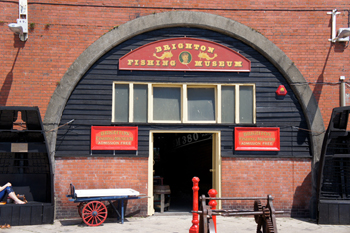 I took a walk along the sea-front, breathing deeply of the sea air, and made a nostalgic detour to the pier, complete with funfair and fish and chips. I visited the small but perfectly-formed Fishing Museum. The fishermen of Brighthelmstone were not best pleased at the arrival of all these new visitors, but they made the best of it.
I took a walk along the sea-front, breathing deeply of the sea air, and made a nostalgic detour to the pier, complete with funfair and fish and chips. I visited the small but perfectly-formed Fishing Museum. The fishermen of Brighthelmstone were not best pleased at the arrival of all these new visitors, but they made the best of it.
The museum houses a full-sized fishing boat, along with plaques and photos and anchors, and delights in telling visitors of the broad-beam hog boats, or hoggies, known locally as ‘knock-arse boats’. Sleek they are not, but they remained stable in rough seas. There’s also a section honouring the boats that went to the rescue at Dunkirk – I can remember my grandmother telling me you could barely see the sea that fateful summer in 1940 for all the boats.
The Royal Pavilion
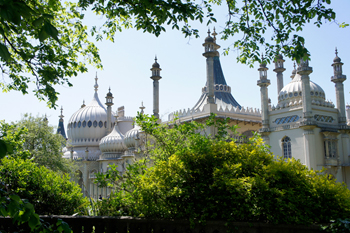 When it came to mistresses and houses, the Prince Regent was a lover of excess. ‘The more, the merrier’ would appear to be his motto. His mistresses were plump and matronly, and his houses extravagant.
When it came to mistresses and houses, the Prince Regent was a lover of excess. ‘The more, the merrier’ would appear to be his motto. His mistresses were plump and matronly, and his houses extravagant.
George moved to Brighton in 1786, escaping both his creditors and the stultifying dullness of the court of St James. He soon rented a farmhouse on the river Steine and, once his financial troubles were sorted out (he had to sell his horse-racing stud) he instructed the architect Henry Holland to convert the house into a dwelling more suitable for the Prince of Wales, as he then was. The result was a beautiful example of neo-classicism.
The Pavilion soon became an alternative court, where a colourful aristocratic circle surrounded the Prince. They were, according to contemporary biographer Robert Huish, “a set of titled cardsharpers.”
But it was not enough. By the 1820s, the house had been transformed into a grand Orientalist fantasy by the architect John Nash, who also designed Buckingham Palace and Marble Arch. The flamboyant mix of Indian and Chinese influences really shouldn’t work, yet somehow it does.
The interior is a riot of chinoiserie, at its most flamboyant in the magnificent Banqueting and Music Rooms, rooms dedicated to two of the Prince Regent’s passions. In the Banqueting Room, the walls are decorated with murals and the table is set for the dessert course. The lamp stands, blue jars of Spode porcelain, are original, as is one of the sideboards, veneered in satinwood and with carved and gilded dragons.
The room is dominated by the dazzling chandelier, a ton in weight, grasped in the claws of a silvery dragon suspended from the ceiling. I’d read that, hidden among all the chinoiserie, are a number of Masonic symbols, and I set about looking for them, the sun and the moon and the All-Seeing Eye. The Prince Regent was the Grand Master of the Prince of Wales Lodge, mostly made up of his friends.
The Music Room is likewise a sumptuous space, lit by nine lotus-shaped chandeliers. The Italian composer Rossini performed here in 1823, by which time the Prince Regent had become King George IV. The room has been fitted with a hand-knotted carpet, a reproduction of the original, made using evidence from surviving fragments and contemporary illustrations, and visitors wearing high-heeled shoes are requested to take them off before entering.
Other rooms are rather more restrained, in an elegantly sumptuous kind of way. I was reminded of a Jane Austen novel, and it occurred to me that I could really do with a chaise longue.
Upstairs are the guest suites and private rooms, complete with heavy silks and four-poster beds. There’s also an art display, including a set of irreverent cartoons satirising the Prince Regent – he was a cartoonist’s dream – and the delightfully cheeky painting HRH The Prince Regent Awakening the Spirit of Brighton, painted by Rex Whistler while he was billeted in Brighton in 1944. I think the Prince Regent would have approved.
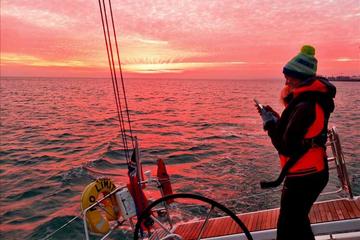
Sailing Sunset Cruise from Brighton
If You Go:
♦ Brighton is easily accessible from London by fast train, departing from either London Bridge or Victoria Station. Rail passes and tickets can be booked at Britrail online.
♦ Apart from trains, some travellers prefer private transfers from London for a smoother ride, especially on day trips. Services like London Wheels Limo offer direct, door-to-door travel.
♦ Information on accommodation, restaurants and Brighton’s plentiful events calendar can be found on the comprehensive Visit Brighton website.
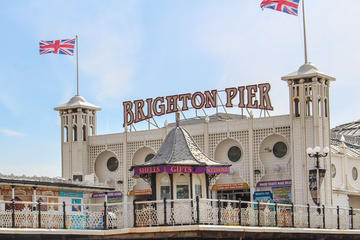
Brighton Pier Tour with Lunch at English Pub
About the author:
Paris Franz is a London-based freelance journalist. She has had work published in a variety of web and print publications, including The Independent, Wanderlust and Europe Up Close. See more of her work at www.parisfranz.com
All photos are by Paris Franz:
Ferris wheel
Fishing Museum
The Royal Pavilion
The Lanes shopping area

